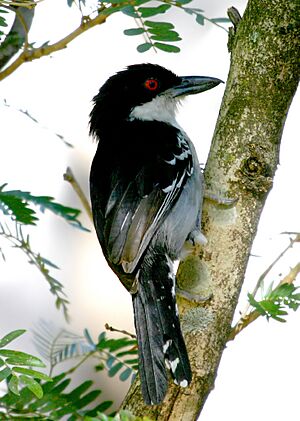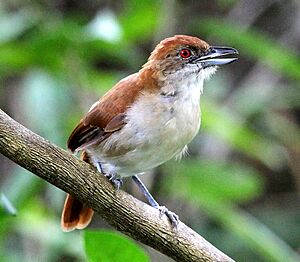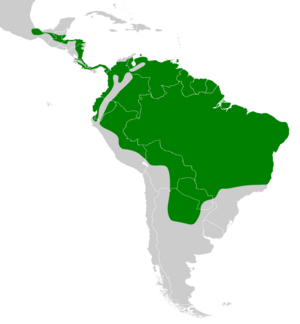Great antshrike facts for kids
Quick facts for kids Great antshrike |
|
|---|---|
 |
|
| A male great antshrike in Alto Paraíso de Goiás, Goiás State, Brazil | |
 |
|
| A female great antshrike in Bonito, Mato Grosso do Sul State, Brazil | |
| Conservation status | |
| Scientific classification | |
| Genus: |
Taraba
|
| Species: |
major
|
 |
|
The great antshrike (Taraba major) is a cool bird that belongs to a family called "typical antbirds". You can find it in many places, from southern Mexico all the way through Central America (except El Salvador) and down into most of South America. It even lives on the island of Trinidad! Sometimes, it might even visit Uruguay for a short trip.
Contents
About the Great Antshrike's Name
The great antshrike got its scientific name, Thamnophilus major, from a French bird expert named Louis Pierre Vieillot in 1816. Later, in 1831, another French naturalist, René Lesson, gave it its current group name, Taraba.
This bird is special because it's the only member of its group, Taraba. It has ten different types, called subspecies, which are like different versions of the same bird. Scientists study their songs to understand how these groups are related.
What Does the Great Antshrike Look Like?
The great antshrike is a big and easy-to-spot bird. It's about 19 to 20 centimeters (7.5 to 7.9 inches) long and weighs between 47.5 to 70 grams (1.7 to 2.5 ounces).
Male and Female Differences
Male and female great antshrikes look quite different. This is called sexual dimorphism. Both have a large crest of feathers on their head, red eyes, and a strong black beak with a hook, like a true shrike.
- Males usually have a black head and black feathers on their upper body. Their wings are black with big white spots that look like bars when they're resting. Their tail is black with white spots. Their throat and belly are white, sometimes with a gray tint.
- Females have a reddish-brown crown on their head. Their upper body is a reddish-yellow-brown color. Their wings are also reddish-yellow-brown with lighter edges. Their tail is rufous (a reddish-brown color). Their chin and chest are white, while the rest of their belly is white with a cinnamon (light brown) tint.
Young great antshrikes have cinnamon or buff (pale yellow-brown) stripes when they are very young. These stripes fade as they get older.
Subspecies Variations
The different subspecies of the great antshrike have small differences in their colors and patterns. For example, some males might have more black on their face, or more white on their tail feathers. Females can also be slightly darker or paler depending on the subspecies.
Where the Great Antshrike Lives
The great antshrike lives in many different places across Central and South America.
Geographic Range
- You can find it from southern Mexico down through Belize, Guatemala, Honduras, Nicaragua, Costa Rica, and Panama.
- It also lives in Colombia, Ecuador, and Peru.
- Further east, it's found in Venezuela, Trinidad, and the Guianas (Guyana, Suriname, French Guiana).
- In Brazil, it lives in many states, from the north to the south.
- It also extends into Bolivia and northern Argentina.
Sometimes, a few birds might wander into Uruguay.
Preferred Homes (Habitats)
This bird likes to live in places with lots of dense plants and trees. It enjoys areas like:
- Forests along rivers (called gallery forests).
- Woodlands in savannas (grassy plains with scattered trees).
- Younger forests that are growing back.
- The edges and open spots of evergreen forests.
- River islands.
- It often hangs out in areas with bamboo plants.
It usually lives in lower elevations, often below 1,000 meters (3,300 feet). However, in some places like Costa Rica, Colombia, Peru, and Venezuela, it can be found higher up, even as high as 2,200 meters (7,200 feet) in Venezuela.
Great Antshrike Behavior
Movement
Great antshrikes usually stay in the same area all year round. However, in Argentina, scientists think they might move around a bit depending on the season.
What the Great Antshrike Eats
The great antshrike eats a variety of things, mostly large insects and other small creatures like spiders. It also eats small snails, tiny mammals, lizards, and even small fish! Sometimes, it eats a little bit of plants too. What it eats can change depending on where it lives.
It usually looks for food alone or with its mate. It stays close to the ground, usually within 5 meters (16 feet) of it, hiding in thick plants. It moves slowly from branch to branch, picking up prey from leaves, stems, and branches. It also often drops to the ground to catch food. In some parts of Brazil, it has even been seen eating water creatures while standing on water plants! Sometimes, it joins groups of different bird species that are feeding together. It might even follow swarms of army ants to catch insects that the ants stir up.
Reproduction and Life Cycle
The great antshrike's breeding season happens at different times of the year depending on where they live. For example, it's from April to July in Costa Rica, and October to December in Argentina.
Their nest is shaped like a cup and is made from different plant materials. They usually hang it from a branch fork or between two branches, often within 3 meters (10 feet) of the ground. They typically lay two or three eggs. In the southern parts of their range, three eggs are more common. The eggs can be creamy white to pale buff (light yellow-brown) in color, but their patterns can vary.
Both the male and female birds take turns sitting on the eggs during the day. At night, only the female sits on them. In Costa Rica, the eggs hatch after 17 to 18 days, and the young birds leave the nest 12 to 13 days after hatching.
How the Great Antshrike Communicates (Vocalization)
The great antshrike's song is usually a long, fast series of about 40 notes that lasts for 5 to 14 seconds. It often ends with a growling sound. However, birds in the northern and western areas tend to sing fewer notes and sometimes don't make the growling sound.
Their calls also change depending on the area. They can make a long, slowing-down rattling sound, shorter rattles, a series of whistling sounds, or harsh notes. Because they like to hide in thick plants, you're more likely to hear a great antshrike than to see one!
Status of the Great Antshrike
The IUCN (International Union for Conservation of Nature) says the great antshrike is a species of "Least Concern." This means they are not worried about it becoming endangered right now.
This bird lives in a very large area, and there are at least five million adult birds. Even though their numbers might be slowly going down, there are no big threats that worry scientists right now. It's quite common in most places where it lives and can be found in several protected areas.
The great antshrike is good at living in different types of habitats, like forest edges and areas where new trees are growing. This helps it survive. However, one subspecies, T. m. stagurus, relies on specific types of forests that are more at risk.


